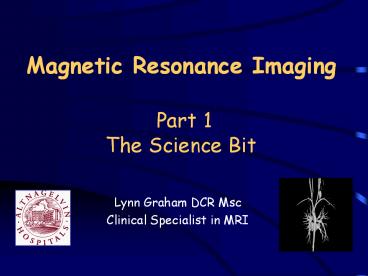Magnetic Resonance Imaging Part 1 The Science Bit - PowerPoint PPT Presentation
1 / 29
Title: Magnetic Resonance Imaging Part 1 The Science Bit
1
Magnetic Resonance Imaging Part 1The Science
Bit
- Lynn Graham DCR Msc
- Clinical Specialist in MRI
2
OUTLINE ( part 1)
- History Local origins of MRI
- Fundamental Physics of MRI
- Tissue contrast Versatility
3
History Lesson
- Carl Fredrich Gauss. (1777-1855)
- German Physicist
- Findings led to a knowlegdge of magnetism and its
quantifiation - Gauss- unit of measurement of magnetism
- Nikola Tesla (1856 1943)
- Serbian Electrical Engineer
- Work in electromagnetic induction
- Tesla unit of measurement for Magnetic Field
strength
4
Sir Joseph Larmor FRS.MA.DSCMathematician
Physicist 1857-1942
- Born 11th July 1857 at Magheragall, Co Antrim
- Educated at RBAI, Belfast
- Graduated from Queens 1877
- Appointed Professor _at_ St Johns College Cambridge
1903 - Knighted 1909
5
The Larmor Equation
- ?L Larmor frequency (MHz)
- B0 magnetic field (Tesla)
- gyromagnetic ratio
Key to Nuclear Magnetic Resonance
6
Nuclear Magnetic Resonance
- NUCLEAR ATOMIC SPIN
- ve electric charge
- Intrinsic spin/ Precession
- nuclear magnetic moment
7
Nuclear Magnetic Resonance
- MAGNETIC MOMENT ALIGNS IN B0
No B0 random motion
B0 alignment
8
Nuclear Magnetic Resonance
- RESONANCE REQUIRES CONSIDEDERATION OF SPECIFIC
PRECESSIONAL FREQUENCY - OF ATOMIC SPINS
Larmour Equation ? ?B0
9
NMR CLINICAL MRI
Fat Water 99 body tissue
H ALIGNMENT PRESCESSION
10
NMR CLINICAL MRI
- Apply the Larmor equation
H1 _at_ 1 T ? 42.58 MHz T-1
_at_ 1.5 T Larmor frequency 63.87 MHz
(falls within the range of radio waves)
11
Resonance Excitation
- Energy absorption happens if spinning nuclei are
hit with radiation at of the same frequency of
the spin - Leads to misalignment with B0
- Also leads to phase coherence.
This is Excitation
12
Relaxation Free Induction Decay (FID)
- Remove the RF and the spins will loose their
energy. - Realign with B0
Loose phase coherance
Energy decays slowly
FID
13
Excitation Relaxation MR Signal
Bo
NMV
90 RF pulse
Current induced in RF coil due to alternating B
field MRI signal
14
Image Formation
15
Spatial Localisation of Pixels
Y
X
Z
16
Image Formation
17
Resolution
Few pixels Short scan time
Many pixels Long scan time
18
Pixel Mapping
Each line of data is stored as the Image is
built up gradually Fourier transform decodes
data forms the image
Phase
Frequency
19
The MR effect!
20
Differing MR Images
- T2
- Fluid bright
- T1
- Fluid dark
21
Relaxation Free Induction Decay (FID)
- The spins will loose their energy in two ways
Energy decays slowly Relaxing back to B0 T1
Recovery
Loose phase coherance T2 decay
22
Brownian Motion
- FAT
- Large , slow molecules
- Lots of bumps
- Fast energy loss
- Short T1 Short T2
- WATER
- Small , fast molecules
- Fewer bumps
- Slow energy loss
- Long T1 long T2
Mr Blobby Vs Speedy Gonzalez!
23
Typical T1 T2 values for tissues (_at_1.5T)
Tissue T1 value T2 value
Distilled water Cerebro Spinal Fluid Gray Matter White Matter Fat Muscle Liver Kidney 3000 2400 900 780 260 750 500 760 3000 160 100 90 80 50 40 30
24
Pulse Sequences
- Pre-set sequences of excitation, relaxation and
signal organization that vary tissue contrast and
image quality.
25
T1 and T2 weightings
- Sag spine T2W
- Fluid bright
- Sag spine T1W
- Fluid dark
26
Tissue differentiation
- gt 99 body tissues produce MR signal
- Each tissue has unique properties
- - molecular
structure - - number of H
ions - -
moving/stationary - Each tissue behaves differently in the MR
environment - ?
- Unique MR signals from normal abnormal
tissues - ?
- Excellent disease
diagnosis.
27
Tissue contrast Versatility of MRI
T1 SE
T2 SE
T1 SE gad
GE brain
28
Tissue contrast Versatility of MRI
Fat sat orbits
FLAIR
Black blood
Angio
29
Coming up Next !!!
- Clinical Applications of MRI
- MRI Equipment
- Safety issues of MRI
- Advantages Disadvantages of MR
- MRI vs Other imaging modalities ( CT/ USS)
- Clinical Images

